The Oocyte Retrieval Needles Market is estimated to be valued at USD 413.4 billion in 2025 and is projected to reach USD 808.4 billion by 2035, registering a compound annual growth rate (CAGR) of 6.9% over the forecast period.
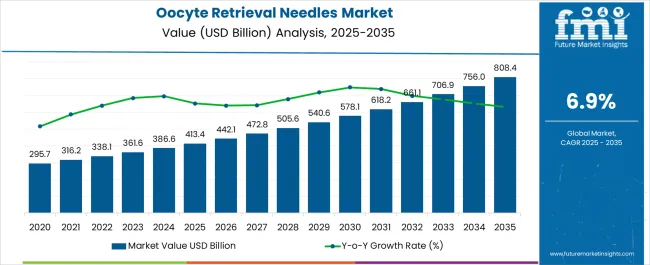
| Metric | Value |
|---|---|
| Oocyte Retrieval Needles Market Estimated Value in (2025 E) | USD 413.4 billion |
| Oocyte Retrieval Needles Market Forecast Value in (2035 F) | USD 808.4 billion |
| Forecast CAGR (2025 to 2035) | 6.9% |
The oocyte retrieval needles market is experiencing sustained growth due to rising demand for assisted reproductive technologies and increasing awareness of infertility treatments. Advances in in vitro fertilization procedures, coupled with a growing number of fertility clinics and supportive regulatory frameworks, are fueling adoption.
The market is further supported by improvements in needle design that enhance precision, minimize patient discomfort, and reduce procedural complications. Growing investments in reproductive healthcare infrastructure across both developed and emerging economies are reinforcing adoption trends.
With increasing maternal age and lifestyle-related fertility challenges, demand for efficient and patient-friendly retrieval solutions is expected to expand. The overall outlook remains positive as innovation in minimally invasive techniques and improved procedural outcomes continues to shape the market’s trajectory.
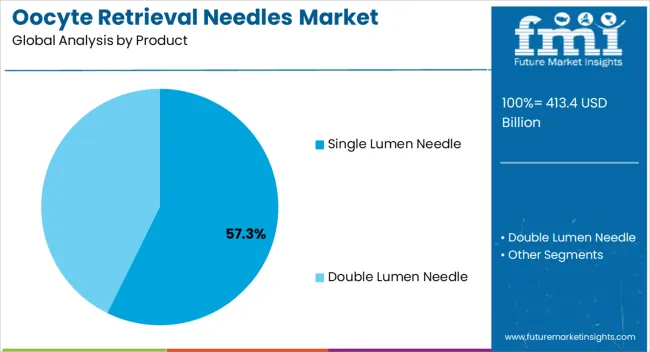
The single lumen needle product segment is anticipated to hold 57.30% of the total market revenue by 2025, positioning it as the leading product type. This dominance is attributed to its widespread adoption in standard in vitro fertilization procedures, cost efficiency, and user familiarity among practitioners.
The design enables effective follicular aspiration with minimal trauma, ensuring reliable oocyte retrieval rates. Additionally, the availability of single lumen needles across a wide range of fertility clinics has supported accessibility and affordability, contributing to higher utilization.
As the demand for assisted reproductive treatments continues to grow globally, the single lumen needle remains the preferred product due to its clinical reliability and procedural efficiency.
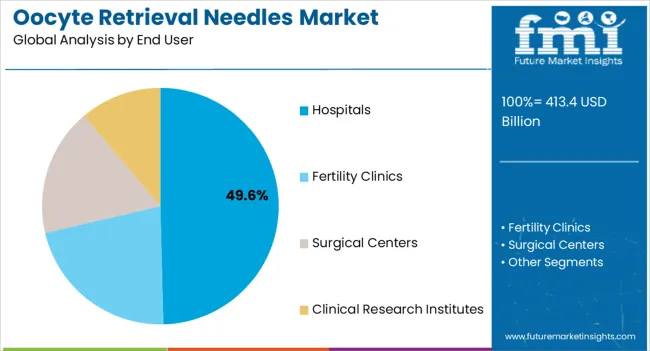
The hospitals end user segment is expected to account for 49.60% of the total market revenue by 2025, establishing itself as the dominant end use category. This leadership is driven by the presence of advanced reproductive technology facilities, specialized staff, and comprehensive healthcare infrastructure in hospitals.
Patients often prefer hospital settings for oocyte retrieval due to enhanced safety protocols, availability of multidisciplinary care, and access to advanced diagnostic support. The ability of hospitals to provide integrated fertility treatment programs, including retrieval, fertilization, and embryo transfer, has strengthened their position.
As demand for infertility treatment services continues to rise, hospitals remain the primary centers for adoption, reinforcing their prominence in the oocyte retrieval needles market.
From 2020 to 2025, the global oocyte retrieval needles market experienced a CAGR of 6.0%, reaching a market size of USD 413.4 million in 2025.
From 2020 to 2025, The market for oocyte retrieval needles has been steadily expanding as a result of developments in assisted reproductive technology (ART) and rising interest in infertility therapies.
Oocyte retrieval needles are made specifically for the removal of oocytes (eggs) during intracytoplasmic sperm injection (ICSI) or in vitro fertilization (IVF). They are commonly utilized in assisted reproduction facilities and play a critical part in fertility treatments.
Future Forecast for Oocyte Retrieval Needles Industry:
Looking ahead, the global oocyte retrieval needles industry is expected to rise at a CAGR of 7.3% from 2025 to 2035. During the forecast period, the market size is expected to reach USD 808.4 million by 2035.
The oocyte retrieval needles industry is expected to continue its growth trajectory from 2025 to 2035, Due to reasons like changing lifestyles, postponed pregnancies, and environmental variables, the prevalence of infertility is predicted to keep increasing globally. In the upcoming years, this is probably going to increase demand for oocyte retrieval needles.
The demand for oocyte retrieval needles is anticipated to rise as more people and couples choose fertility procedures like IVF and ICSI. This demand may be influenced by variables like shifting societal standards, more awareness, and easier access to fertility clinics.
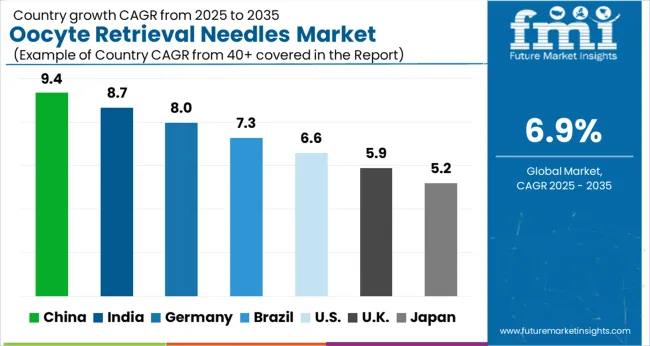
| Country | The United States |
|---|---|
| Market Size (USD million) by End of Forecast Period (2035) | USD 808.4 million |
| CAGR % 2025 to End of Forecast (2035) | 7.8% |
The oocyte retrieval needles industry in the United States is expected to reach a market size of USD 808.4 million by 2035, expanding at a CAGR of 7.8%. The number of infertile couples in the US has been gradually increasing.
The rising need for reproductive procedures like IVF and ICSI is influenced by variables like postponed pregnancies, lifestyle changes, and environmental factors. Oocyte retrieval needle demand is consequently increased as a result.
| Country | The United Kingdom |
|---|---|
| Market Size (USD million) by End of Forecast Period (2035) | USD 42.2 million |
| CAGR % 2025 to End of Forecast (2035) | 8.0% |
The oocyte retrieval needles industry in the United Kingdom is expected to reach a market share of USD 42.2 million, expanding at a CAGR of 8.0% during the forecast period. For those who meet the criteria, the National Health Service (NHS) in the UK offers access to fertility treatments.
The accessibility and affordability of these services are improved by the availability of NHS-funded fertility treatments, including oocyte retrieval operations. This helps the UK market for oocyte retrieval needles to expand.
| Country | China |
|---|---|
| Market Size (USD million) by End of Forecast Period (2035) | USD 53.6 million |
| CAGR % 2025 to End of Forecast (2035) | 7.6% |
The oocyte retrieval needles industry in China is anticipated to reach a market size of USD 53.6 million, moving at a CAGR of 7.6% during the forecast period. To address the issue of infertility and advance assisted reproductive technologies, the Chinese government has put supportive regulations and programs in place.
These include actions like easing the restrictions on family planning, enhancing the infrastructure for healthcare, and funding fertility treatments. Such government assistance promotes the market expansion for oocyte retrieval needles.
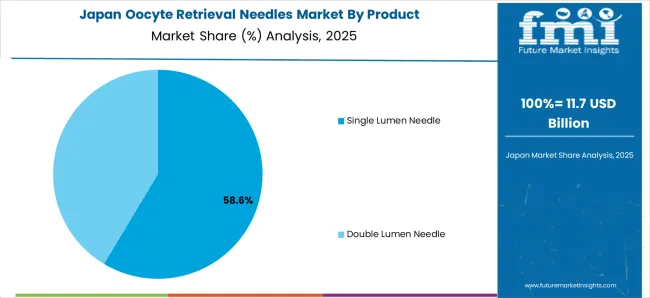
| Country | Japan |
|---|---|
| Market Size (USD million) by End of Forecast Period (2035) | USD 39.3 million |
| CAGR % 2025 to End of Forecast (2035) | 7.5% |
The oocyte retrieval needles industry in Japan is estimated to reach a market size of USD 39.3 million by 2035, thriving at a CAGR of 7.5%. The healthcare system in Japan is well developed and includes assisted reproduction facilities and specialized fertility clinics.
These facilities have cutting-edge technology and a high rate of adoption of cutting-edge oocyte retrieval needle designs. The presence of cutting-edge healthcare infrastructure facilitates market expansion.
| Country | South Korea |
|---|---|
| Market Size (USD million) by End of Forecast Period (2035) | USD 29.1 million |
| CAGR % 2025 to End of Forecast (2035) | 7.2% |
The oocyte retrieval needles industry in South Korea is expected to reach a market size of USD 29.1 million, expanding at a CAGR of 7.2% during the forecast period. In terms of medical tourism, South Korea has become a well-liked location for fertility procedures.
International patients seeking fertility treatments are drawn to the nation because of its reputation for providing high-quality healthcare services, cutting-edge technologies, and skilled healthcare experts. As a result, the market for oocyte retrieval needles is expanding.
The Single Lumen Needle is expected to dominate the oocyte retrieval needles industry with a CAGR of 7.6% from 2025 to 2035. This segment captures a significant market share in 2025, in order to lower the possibility of contamination and infection during oocyte retrieval techniques, single lumen needles were developed.
They reduce the possibility of cross-contamination between the needle and the surrounding area by only having one hole or lumen. Their greater use in clinical settings due to their enhanced safety profile is what is causing the market to rise overall.
The Fertility Clinics segment is expected to dominate the oocyte retrieval needles industry with a CAGR of 7.5% from 2025 to 2035. Oocyte retrieval needles are in high demand since fertility clinics are the main providers of assisted reproductive technologies (ART), such as IVF and ICSI.
Oocyte retrieval is a crucial step in these treatments, which these facilities provide to individuals and couples struggling with infertility. The demand for oocyte retrieval needles is directly impacted by the expansion of fertility clinics and the growing number of patients they serve.
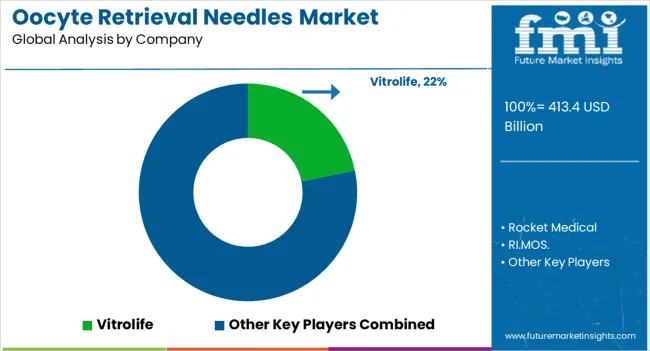
The oocyte retrieval needles sector is fiercely competitive, with many companies fighting for market dominance. To stay ahead of the competition in such a circumstance, essential players must employ smart techniques.
Key Strategies Used by the Participants
Product Development
To develop innovative goods that increase efficacy, dependability, and cost-effectiveness, businesses make significant investments in research and development. Product innovation allows companies to stand out from the competition while also meeting the shifting needs of their customers.
Strategic Alliances & Collaborations
Strategic relationships and alliances with other businesses are regularly formed by major players in an industry to take advantage of each other's advantages and expand their market reach. Through such partnerships, businesses may also obtain access to novel innovations and markets.
Expansion into Emerging Markets
The market for oocyte retrieval needles is rising quickly in developing nations. To strengthen their presence in these regions, key companies are expanding their distribution networks and building local manufacturing sites.
Acquisitions and mergers
Leading companies in the oocyte retrieval needles industry frequently use mergers and acquisitions to consolidate their market positions, broaden their product offerings, and enter new markets.
Key Developments in the Oocyte Retrieval Needles Market:
The global oocyte retrieval needles market is estimated to be valued at USD 413.4 billion in 2025.
The market size for the oocyte retrieval needles market is projected to reach USD 808.4 billion by 2035.
The oocyte retrieval needles market is expected to grow at a 6.9% CAGR between 2025 and 2035.
The key product types in oocyte retrieval needles market are single lumen needle and double lumen needle.
In terms of end user, hospitals segment to command 49.6% share in the oocyte retrieval needles market in 2025.






Our Research Products

The "Full Research Suite" delivers actionable market intel, deep dives on markets or technologies, so clients act faster, cut risk, and unlock growth.

The Leaderboard benchmarks and ranks top vendors, classifying them as Established Leaders, Leading Challengers, or Disruptors & Challengers.

Locates where complements amplify value and substitutes erode it, forecasting net impact by horizon

We deliver granular, decision-grade intel: market sizing, 5-year forecasts, pricing, adoption, usage, revenue, and operational KPIs—plus competitor tracking, regulation, and value chains—across 60 countries broadly.

Spot the shifts before they hit your P&L. We track inflection points, adoption curves, pricing moves, and ecosystem plays to show where demand is heading, why it is changing, and what to do next across high-growth markets and disruptive tech

Real-time reads of user behavior. We track shifting priorities, perceptions of today’s and next-gen services, and provider experience, then pace how fast tech moves from trial to adoption, blending buyer, consumer, and channel inputs with social signals (#WhySwitch, #UX).

Partner with our analyst team to build a custom report designed around your business priorities. From analysing market trends to assessing competitors or crafting bespoke datasets, we tailor insights to your needs.
Supplier Intelligence
Discovery & Profiling
Capacity & Footprint
Performance & Risk
Compliance & Governance
Commercial Readiness
Who Supplies Whom
Scorecards & Shortlists
Playbooks & Docs
Category Intelligence
Definition & Scope
Demand & Use Cases
Cost Drivers
Market Structure
Supply Chain Map
Trade & Policy
Operating Norms
Deliverables
Buyer Intelligence
Account Basics
Spend & Scope
Procurement Model
Vendor Requirements
Terms & Policies
Entry Strategy
Pain Points & Triggers
Outputs
Pricing Analysis
Benchmarks
Trends
Should-Cost
Indexation
Landed Cost
Commercial Terms
Deliverables
Brand Analysis
Positioning & Value Prop
Share & Presence
Customer Evidence
Go-to-Market
Digital & Reputation
Compliance & Trust
KPIs & Gaps
Outputs
Full Research Suite comprises of:
Market outlook & trends analysis
Interviews & case studies
Strategic recommendations
Vendor profiles & capabilities analysis
5-year forecasts
8 regions and 60+ country-level data splits
Market segment data splits
12 months of continuous data updates
DELIVERED AS:
PDF EXCEL ONLINE
Pen Needles Market Analysis - Size, Share, and Forecast Outlook 2025 to 2035
Suture Needles Market Size and Share Forecast Outlook 2025 to 2035
Tattoo Needles Market Size and Share Forecast Outlook 2025 to 2035
Safety Needles Market Size and Share Forecast Outlook 2025 to 2035
Specimen Retrieval Nets Market
Blood Clot Retrieval Devices Market Size and Share Forecast Outlook 2025 to 2035
Retractable Needles Market
Vertebroplasty Needles Market Size and Share Forecast Outlook 2025 to 2035
Transabdominal Retrieval Kits Market
Special Purpose Needles Market Analysis – Growth & Forecast 2025 to 2035
Aspiration & Biopsy Needles Market Analysis - Trends & Forecast 2025 to 2035
Endoscopic Ultrasound Needles Market Size and Share Forecast Outlook 2025 to 2035
Botulinum Toxin-coated Microneedles Market Size and Share Forecast Outlook 2025 to 2035
Automated Compound Storage and Retrieval (ACSR) Market Size and Share Forecast Outlook 2025 to 2035
Latin America Hypodermic Syringes and Needles Market Analysis & Forecast by Type, End Users, and Region Through 2035

Thank you!
You will receive an email from our Business Development Manager. Please be sure to check your SPAM/JUNK folder too.
Chat With
MaRIA